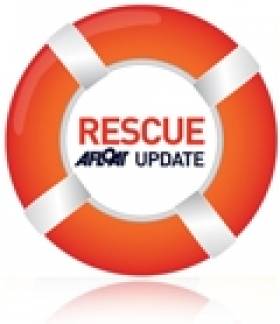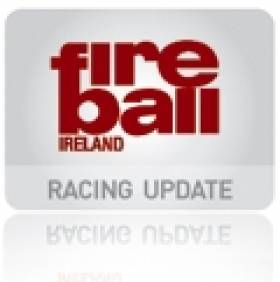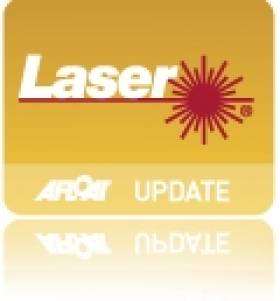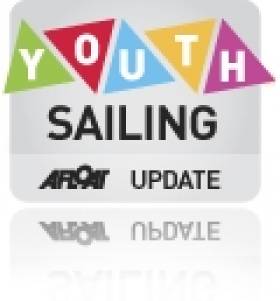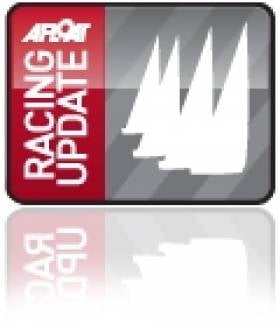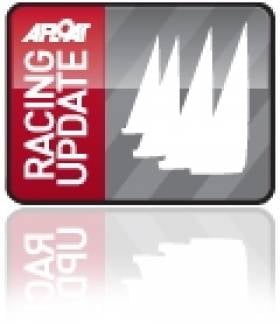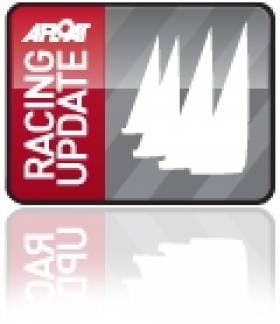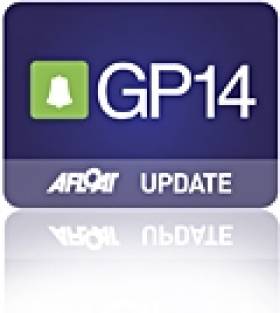Displaying items by tag: Dinghy
Man in Serious Condition After Falling Overboard Off Clare
Breaking News reports that the individual was seen experiencing difficulty in the sea north of Kilkee, close to Donegal Point.
The Irish Coast Guard and Kilkee Marine Rescue Service immediately mounted a rescue operation, and the man was removed from the water by rescue helicopter to Limerick's Mid Western Regional Hospital.
The man is believed to be in a serious condition.
Colin Succeeds Bradley as Irish Fireball Chief
New Sponsor for Cork Laser Frostbites
Youth Boat Selection Requires Leadership
There has been a call for the Irish Sailing Association (ISA) to take a lead in the big decisions that face youth sailors on what classes to sail to after they leave the ranks of the Optimist, Topper and Feva classes. The call comes from a leading junior organiser who does not wish to be named.
Although youth sailing is buoyant in Ireland it is known there is a 'high attrition rate' among teenagers. The lack of transfer in to senior dinghy classes has been a cause of concern for many clubs around the country.
The comments follow a recently published article on Afloat.ie promoting the RS 200 dinghy as a progression boat for juniors.
"We need a class that will keep youths engaged. The 420 and 29er are great boats but require higher levels of boathandling, are much more competitive and tend to attract the top sailors"
"While the ISA's Olympic ambitions are great to see, it will fail the sport as a whole if it does not tackle this gaping need, the organiser says.
Read the RS 200 article by Ciara Byrne and the junior organiser's comments here
Reviewing The Top OK Dinghy Gear
News that the OK Sailing Dinghy is knocking on the door in Ireland means it might be a good time to take a look at the gear used by the top 10 sailors at the recent OK Dinghy World Championships in Largs, Scotland. It would be easy to assume that New Zealand has somewhat of a monopoly on fast OK Dinghies. Five of the hulls, six of the sails and all 10 of the masts were of New Zealand origin in some shape or form. Robert Deaves reports.
The event this year was mainly held in light and shifty winds, so for some sailors the value this of data is perhaps reduced, however it is true to say that the top sailors rose to the top as they normally do. There were no real surprises.
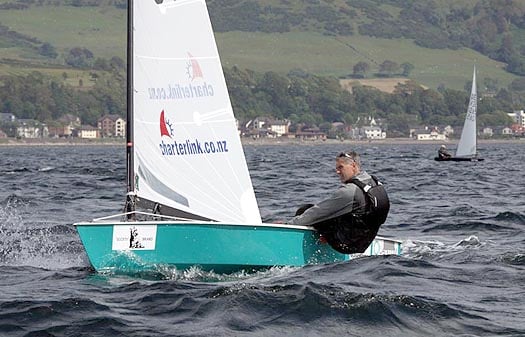
Alistair Deaves racing in Largs
To underline the competitiveness of this year's championship it is worth looking at the credentials of the top 10. Four were former World Champions, four were former Interdominion Champions, three were former Nordic Champions and eight were former National Champions. It was a top class field.
Hulls
The New Zealand made OK Dinghies from Icebreaker Boats NZ seem to be the boat of choice at the moment as many of the top sailors have chosen this builder. They have also won almost every major event of the past three years.
The Icebreaker shape goes back to the late 1960s when it was one of several designs from Alf Lock of Auckland. The fastest of his boats was used to take a mould and the Icebreaker came into existence. The boat has generally flat sections aft with minimal rocker and a fine entry to the bow. Upwind it tracks well and doesn't 'float' around as some of the fuller boats do. Offwind, while a fuller bowed boat would get into the plane slightly earlier, once the Icebreaker does, it has a faster top speed. In the light it is easy to handle and not as 'sticky' as some other designs.
Before 2008, Icebreaker hulls were really hard to get hold of outside New Zealand. The Kiwis didn't want the rest of the world to buy into their fast boats, and even though the mould passed through a number of hands, there was never much interest in exporting. But all that changed when Alistair Deaves took over the well used mould, refurbished it and to started to market the boat worldwide, no doubt helped by Karl Purdie (NZL) winning the 2008 World Championships in one of the first production boats.
However, according to Deaves, this is not the whole story. "The way the boat is constructed also plays a large part and Icebreaker Boats NZ has used modern computer design methods and materials to provide, what we think, is the best OK in the world. As much work as necessary is outsourced to ensure we get the best of everything."
"But of course the real reason why Icebreaker Boats NZ has such a good record is that we managed to sell to some of the best sailors, and perhaps that's the best endorsement of all. This is achieved by a policy of good quality and exceptional service, and customers often come back for new boats."
The moulding work for New Zealand Icebreakers is carried out in Auckland by Chris Brown of Performance Composites with the boats finished and marketed by Deaves through Icebreaker Boats NZ.
If it wasn't for the decline of the world economy, he says many more OK sailors would have chosen New Zealand made Icebreakers. "The import price was hiked out of reach for all but the rich and dedicated. In addition, some sailors pushed for copies of the Icebreaker to be made in Europe which has now led to three builders producing similar, but relatively cheaper copies."
Despite the crippling exchange rates some European buyers are still importing Icebreakers from New Zealand, though Deaves does admit that he has lost a lot of potential orders because of the complete nose dive in currency.
This season, like last season, Kiwi built Icebreakers have won most of the major events including the Interdominions, Spring Cup, Kiel Week, Warnemunde Week as well as many Nationals across Europe. It has also won five of the last seven world championships and last year's Europeans.
Ironically, though different NZ Icebreaker hulls won each and every race of this year's world championship, the highest place it achieved in the final overall standings was third. The championship was actually won by an Icebreaker copy, or Scolesbreaker, as it has been called, taken from Nick Craig's three times world championship winning New Zealand Icebreaker (though from a previous builder before Brown/Deaves) and built by Alex Scoles of UK based Idol Composites.
Though Craig sailed the most consistent series, by his own admission, he was not the fastest in the conditions at Largs. But, he said, "I am very pleased with my Scoles boat. Alex put in a lot of time ensuring the mould was perfectly fair, which has paid dividends with a fast and well-constructed boat that has a very long competitive life. It's nice to be able to focus on improving my rig whilst being 100% confident that my boat is fast."
Scoles commented, "It has been great for Idol Composites to have a world championship winning product and now my order book is bulging. The exchange rate has made Icebreaker Boats more expensive, but I don't think this had any significant impact on my orders so far."
In the last couple of years Idol Composites has sold OKs to the UK, Germany, Belgium, Ireland, Canada and Norway. This year it has had to take on extra staff and is looking to build more than 20 boats over the next 12 months. These are mainly for UK and Danish customers, though he also has potential orders from Sweden and Poland. Scoles also hopes to be able to ship a container full to Australia over the winter.
Idol composites offers what is considered the stiffest OK Dinghy available anywhere in the world. Everything is done in-house including the laminating, the painting and building the foils to maintain the high standards of build quality. As well as the standard gel coat finish, Idol Composites also offer 2-pack painted boats, which most of Scoles' customers opt for because of the saving in weight.
Scoles summed up his success, "It's a quality product together with a world title in a hull shape that OK sailors want." And that perhaps is the key. The Icebreaker shape is a shape from the past that everyone wants in the present.
However, all the other hulls in the top 10 are also old designs. The Hein is a German hull, with a fuller bow, the Rushworth is a copy of UK built Don O'Donnell hull from the 1970s and the Delfs copy is, as it suggests, a copy of the Swedish Delfs hull but built in Australia, with a full bow and very flat rocker that was very popular through the 1980s.
As ever there is nothing very new in the design of OK Dinghy hull shapes. As long as it is stiff, fair and down to weight, an old hull can be just as competitive as a new hull.
Masts
On an OK Dinghy, the mast is often considered the most important piece of kit. It is far more important that the hull or the sail, though of course the sail has to work with the mast to be any use. The move to carbon masts in 2004 sparked a lot of development worldwide, but in recent years the C-Tech mast from New Zealand has emerged as the most popular choice, principally after a lot of work from double world champion Karl Purdie (NZL). Even Craig has switched to a C-Tech after winning his first three titles with a Dutch built Celidh mast.
Out of any piece of kit on an OK Dinghy, C-Tech probably has the biggest market share. However, again, cost has become an issue as the exchange rate fell, opening up new development projects in Europe. But there is still some way to go on these.
Other masts in Largs included the UK built Aardvark and the Celidh.
Sails
Six out of the seven race wins in Largs were taken by sails built by Kiwis. Five of these were from Quantum Sails Potsdam, in Germany. The loft is run by Greg Wilcox, a former OK Dinghy world champion from New Zealand.
Wilcox, who himself finished fourth in Largs, explained, "Quantum Sails are individually made and matched to the sailor's weight, fitness level and, of course, mast bend. A lot of the other sails on the market are pre-made and the luff curve added last. This means there is really only one sail whereas we have a few different designs for different sailors."
"Our sails seem to have a bit of an edge when the conditions are quite varied. They seem to be very quick all round and especially downwind. I have worked with the top guys in the class like Karl Purdie and Thomas Hansson-Mild to develop the designs. They are both quite analytical and experienced and have provided very good feedback. I think this is obvious when they have won three of the last four worlds between them using these sails."
"Cloth choice is also very important however most sailmakers use Contender sailcloth which is very stable, light and reasonably durable. We try to get consistent cloth and work with our supplier towards this."
Craig used a UK built Speed sail, developed in conjunction with 2004 OK Dinghy World Champion Jim Hunt, but was never that happy with its light wind performance. Danish Green sails are very popular in Germany and Denmark and have been a key sailmaker for the class for decades. It's a similar story for Gale & Rimmington for Australia, though they tend to perform best in the windier conditions, something not experienced in Largs this year.
Other sails used in Largs include Pinnell & Bax from the UK, North from New Zealand, WB from Finland, Cicada from Germany and Linton from New Zealand.
Summary
Overall, whether by design or by choice, Kiwi knowledge and experience has produced some of the fastest combinations in the OK Dinghy in recent years and this trend looks set to continue. The main restriction for Europeans, and Americans, is the exchange rate, and before that returns to normality, if it ever does, the rest of the OK world needs to play catch up, or as in some cases, follow the same successful formula.
Table: Top 10 Gear at 2011 OK Dinghy World Championships
Shape Builder Sail Mast Board/rudder
1 Icebreaker copy Scoles Speed C-Tech Scoles
2 Hein. Hein Green C-Tech Hein
3 Icebreaker Icebreaker NZ Quantum C-Tech Jason King/KL
4 Icebreaker Icebreaker NZ Quantum C-Tech Deaves/C-Tech
5 Icebreaker Icebreaker NZ Linton/Quantum C-Tech Bumblebee
6 Rushworth Rushworth Quantum C-Tech Rushworth
7 Icebreaker Icebreaker NZ Green C-Tech Deaves
8 Icebreaker Icebreaker NZ Quantum C-Tech Deaves/C-Tech
9 Hein Hein Quantum C-Tech Hein
10 Jason King Delfs copy Gale & Rimmington C-Tech Jason King
Interest in OK Dinghy in Ireland
The OK dinghy is perhaps the most internationally active non-Olympic single handed dinghy. It's a classic design, but fully updated now with carbon mast to match the excellent handling. It's sailed in the UK, France, Belgium, Germany, the Nordics, Australia, New Zealand, and there's renewed activity in historically active countries like the Netherlands, the USA and Canada....with the Asian fleets - as always - small but persistent.
The class in Ireland is still small, but there's interest in both North and South, and a new class association website here
We're told there'll be a few boats on the water in 2012 to show off the advantages of this class, and there are several people interested in finding boats during next year.
Nick Craig Reflects on Fourth OK Dinghy World Title
Nick Craig chats to Robert Deaves after his record-equalling fourth OK Dinghy World title
How times have changed. A little over seven years ago, no British sailor had ever won the OK Dinghy World Championship. It was a commonly held belief in the class that no British sailor ever would. They were just not up to the job, or jinxed by 50 years of history. Jim Hunt changed all that in 2004 with a decisive win on home ground at Parkstone on the UK's south coast.
Then it was Nick Craig's turn, winning the title in 2005, 2006 and 2007 to become only the third person to win three titles and only the second to win three in a row. This year in Largs, Scotland, Craig won it for a record equalling fourth time after one of the trickiest and closest world championships ever held.
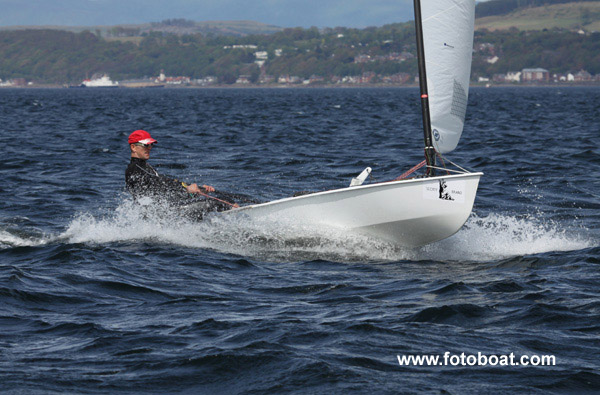
Craig joins Leith Armit (NZL), who won in 1983, 1985, 1990 and 1994, and Bo-Staffan Andersson (SWE) who won in 1988, 1991, 1992, 1993, as the only sailors to have won the title four times.
In addition, Craig rises to the top of the 'Best OK Dinghy sailors of all time' list, overtaking class legend Jørgen Lindhardtsen (DEN).
Several weeks after the win, Craig reflected on the regatta. It was not the easiest of weeks, plagued by light and unstable winds and unusually high temperatures. Only seven out of the ten scheduled races were held after several long days on the water with very little to show on the scoreboard.
Craig said, "However, it was a very well run event. On shore side, it was one of the best events I've done. The family and friends events were organised by Sue Byers. There were activities every day, which meant my wife and kids had a great time which is very important."
"It's just a shame the wind didn't play ball. The sailing was very challenging with light, unstable winds, but the race team made the best of it so we raced in the best conditions available."
What were his expectations going into it the regatta and how did that change during the week? "I was aiming to win but stayed pretty philosophical with the difficult conditions. I was sailing my best and if the wind was a bit random there wasn't a lot I could do about it. I didn't open the week well with a 16th and then an 11th in race three but I knew it would be high scoring so I just kept plugging away."
And the threats? "It was as expected – a great mix of experience in past World Champions Thomas Hansson-Mild (SWE) and Greg Wilcox (NZL) and new blood from Bartosz Rakocy (POL). In light winds I expected the German team to be fast which they were and in breeze the Aussies are fast."
After finding great speed in years past to win three world titles with his Celidh mast and North sail combination, Craig has struggled with speed issues in recent years, after the rest of the world caught up. And to some extent this still dogged him in Largs. "The biggest challenge was my lack of pace in the very light airs. I was just off the pace upwind in sub-hiking conditions, which made life very difficult on the big course. I was having to start very aggressively and get all the shifts right to get any decent results in these conditions."
The event had started on a low point for Craig. "My car, which was packed for the event and a two week family holiday, was stolen from the sailing club the weekend before the event and it made the week before very hectic with replacing the car, towbar, clothes, cot bed, credit cards and sailing kit as well as going to work. The biggest low point was how useless the police were – the thief phoned my wife on my phone so could easily have been caught."
And once into the racing, he didn't have the best start. "The opening race was pretty horrible for me. I got a great start but my pace was ordinary, I got on the wrong side of the last shift into the windward mark, and then got killed when the second reach turned into a run so I just scraped a 16th."
However the championship was still wide-open going into the seventh and final race, held right on the time limit. Craig, who was in fourth place overall, needed things to go his way. "The highlight of the event for me was the first beat of the last race. I got a bit lucky - there was a shift and new breeze on the left which I was in so I rounded the top mark first with none of my competition in the top 20."
"After that stroke of good fortune, it was still a tricky race. The wind stayed very light and I again struggled a bit for pace so slipped to fourth through the race whilst Greg Wilcox was coming through quickly. The run was painful as the leeward marks were moved to make it longer and the wind filled in from behind so at one point it looked like I'd be engulfed by the chasing pack. The fleet then inevitably split at the leeward gate but thankfully the wind filled in on my side so I clung on to take the title by just two points."
What does a fourth world title mean to him? "It means a lot – winning it this time round was in many ways a lot harder than any other time as I'm sailing less so it's harder to get an edge."
"The rigs have also moved on a lot over the last few years and I've been behind as I've been sailing other boats and doing less sailing. But I'm happy that I've now got a rig that works well across the wind range. I've got no edge though, so I'll be trying a few things over the winter to find that edge again."
Craig is without doubt an OK Dinghy fanatic, but sees the need for the class to promote itself in a crowded market. "The class needs to keep playing to its strengths of great international racing and low cost close racing in a good fun atmosphere. It is hard to promote that in the UK because it is a very crowded market and there are big companies promoting their boats hard. But the OK has a unique mix of enjoyable racing that should see it continue to thrive."
The class has lined up some great venues for the next few years. In 2012 the world championship is being held in Denmark, while in 2013 the class heads to Thailand for the first time, before travelling down under to Melbourne in 2014.
Craig is certainly game to try for a record fifth world title. "It would be fantastic and I will go for it, more because I love racing the OK Dinghy internationally than because five is a magic number. I hope to have many more years of great international sailing and beer drinking."
"But I know it will be hard. There is some great young talent coming through the class as well as some very experienced hands who are tough to beat."
Photo by Alan Henderson, fotoboat.com
A healthy forty seven dinghies competed for the Irish GP14 National Sailing Championships title last weekend and Greystones sailor Shane McCarthy, now UK based, with crew Andy Davis took the title, winning the last four races. Class president Richard Street gives a blow by blow account of how the title was won.
Skerries was our venue, and a fine spot to host a regatta it is .The GP fleet were really well taken care of by all the members of the club who put aside their own weekend so we could have a lot of fun. Thank you.
Not only were we blessed to have a great turnout, but the calibre of it was pretty impressive too. The top ten counted two World Champions, a European Champion, a two time Olympian, a six time Irish National champion, a multiple English National Champion. Steven Nelson and his brother Jonny slotted right in amongst them to blow most of the Gold fleet away and take the crown in their division by a huge margin.
Race officer Liam Dineen and his crew spent a long weekend at sea for our enjoyment a massive thank you to him and his team. Sunday, especially can not have been easy.
On day one Mike Senior and Chris White were consistency personified, two races, two bullets, as were Shane Mc Carthy and Andy Davis with two seconds.
Race one paid off beautifully for those who headed straight inshore on the first beat, but if you made the mistake of repeating that on the second beat you got hosed. Main feature of the weekend was big breeze and some massive shifts. Keith Louden and Dessie Hughes got their result of the weekend with a third skinning their northern rivals theyoung Mc Guinness boys in the process.cue smiles allround.On one boat.
Race two and a big right shift up the last beat got a few boats that weren’t looking too hot, out of trouble . Curly once had a boat by that name, I think, and he and Laura were chased into third by his daughter Melanie crewing for Ger Owens. Their boat name? True Belle.
Day two Sunday, blowing hard enough that rumour has it the RO wasn’t sending us out. A few launches put paid to that, and we’ve raced in far worse.
The Imperious English pair got their first challenge as Shane and Andy took their first win. They had been led around the first windward mark by Steven and Jonny, as fine a sight as ever we’d see…until they repeated the feat the following day ! Now if the two boys had popped the kite they might have held on to the lead , but they got swallowed up. Mike and Chris had to work to hold onto the leaders and were chased home by Dave Young and Seonaid Fleming who registered their high point for the series. The effort must have taken its toll as they spent a large portion of the afternoon swimming, which meant utter exhaustion for them by the end of the day.Still smiling though.
Race four looked like it might never happen. 30 and 40 degree windshifts coming down the course with each cloudburst. Rain that was thick as fog and more than one attempt at starting which had to be abandonded with twenty seconds to go. Inevitably when the gun did go, a line that ten seconds earlier had been pin end favoured but congested,suddenly got much more so. A big shift to the left saw the fleet react, but back up the line , with room to move, Niall Henry and James Conlon crossed on port at full tilt to negate much of the advantage those by the pin had. In the lightest breeze of the weekend and heading straight into a short steep chop concentration was essential, lose it and you got spat out the back.
The end of that race saw the score tied at two all as Shane took the win followed by Mike Senior.
With a building breeze and direction settling, the course swapped to a quickfire windward leeward. The two leading boats at the top mark both missed the wing, the boys behind said thank you very much. A short windward leg meant a hectic pressurised run, nothing settled until halfway up the second beat. There was little time to catch breath, let alone think. At the end the overall result had reversed itself. While both incredibly consistent, the Irish boat had scored three bullets to Mikes two.
Monday morning, cold and grey. The final denoument. Race five, again a windward leeward and a great breeze, a tight stack at the top mark meant boat handling was at a premium, who popped out in the lead at the top, Shane and Andy, with a narrow lead over a chasing pack which had buried in it the challenger , Mike and Chris had to work hard to stay in contention, those running down the left side of the second run weren’t looking too good until a nice right shift came in making it all look sweeter. At the bottom the Mc Guinness brothers took the stb gate while Shane went to the left, they rounded in exact sequence but someone had picked the wrong side. Shane and Andy took the gun and with it the title. Curly Morris and crew Laura Mc Farland had come around the bottom three or four back but played a beautiful final beat to come away with second.
The new Champions headed for shore and a tepid shower, while a new winner Clive Goodwin and Thomas stepped up onto the podium in race seven.Nigel Sloan and Micheal Cox had a stunning race to fend off an Olympian and grab second place. Well done boys.
Irish National Champions 2011. Shane Mc Carthy and Andy‘ Taxi ‘ Davis.
Runners up, Mike Senior and Chris White.
Winners in the Silver Fleet Steve Nelson and his brother Johnny.
Winners of the Bronze fleet ,local Skerries crew,Shay McGee and Owen Boylan.
Well done Skerries. And thank you.
Inquest Hears Man Drowned After Dinghy Capsized
Two children looked on in horror as their father tried to save a drowning man, an inquest has heard in Belfast.
As the Belfast Telegraph reports, the family and a friend were thrown into Strangford Lough when their dinghy capsized some 500 yards from Newtownards Sailing Club on 12 June last year.
David Allen managed to pull his friend Ken Dorman to safety and performed mouth-to-mouth resuscitation while still in the water.
But Dorman, 51, had been shocked by the cold water and swallowed some, which caused him to drown, ruled coroner John Leckey.
Allen described his friend as strong and a good swimmer, and told of his shock when he saw him floating on his back unmoving after he was unable to inflate his buoyancy aid.
"He did not make any attempt to move at all and that is what I struggle with," said Allen. "I think there was something stopping him from doing anything."
The Belfast Telegraph has more on the story HERE.


























